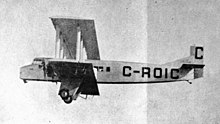
Golden Green is a village in the Medway valley near Tonbridge in Kent, England. It is 1 mile (1.6 km) from the larger village of Hadlow and 4 miles (6 km) from the town of Tonbridge.
The Farman F.120 were a family of multi-engine monoplane aircraft designed and produced by the French aircraft manufacturer Farman Aviation Works. It was operated in a diverse range of purposes, including as a commercial airliner and as a military bomber aircraft.

The Société Générale des Transports Aériens (SGTA) was a French airline founded in 1919. It operated until 1933 when its assets were incorporated in the newly created Air France airline.

The 1922 Picardie mid-air collision took place on 7 April 1922 over Picardie, France, involving British and French passenger-carrying biplanes. The midair collision occurred in foggy conditions. A British aircraft flying from Croydon to Paris with only mail on board collided with a French aircraft flying three passengers from Paris to Croydon, which resulted in seven deaths.
The Compagnie des Grands Express Aériens was a pioneering French airline established 20 March 1919 and operating until merged with Compagnie des Messageries Aériennes to form Air Union on 1 January 1923.

The Farman F.50 was a French twin-engined night bomber designed and built by Farman as a replacement for the single-engined Voisin pusher biplanes in service with the French Air Force.

The Farman F.70 was a 1920s French passenger and mail transport aircraft designed and built by the Farman Aviation Works. It was a smaller counterpart to the company's popular F.60 Goliath. The F.70 was an unequal-span two-bay biplane with a wooden fuselage and was powered by a Renault 12Fe piston engine. The pilot was seated in an open cockpit behind the nose-mounted engine. Behind the open cockpit was a cabin for four passengers or freight.

The Farman F.160 was a heavy bomber aircraft developed in France in the late 1920s. It was essentially an attempt by Farman Aviation Works to modernise its tremendously successful F.60 Goliath design of the immediately postwar years. The most noticeable external difference was the larger tailfin of the new aircraft. Like its predecessor, it was a large three-bay biplane of conventional configuration with unstaggered wings of equal span. Initially conceived as a heavy night bomber, most examples built were float-equipped torpedo bombers for the Aéronautique Maritime, which operated some 40 of the F.165 variant and 200 of the F.168. One of the original F.160 night bombers was exported to Italy, and one to Japan. Plans to develop airliner versions did not progress past the prototype stage.

The Farman F.190 was a utility aircraft built in France in the 1920s and 1930s. It was a high-wing, strut-braced monoplane of conventional configuration with a fully enclosed cabin and fixed, tailskid undercarriage. Popular both as a private aircraft and in the air taxi role, some 30 examples were also operated by airlines in France and elsewhere in Europe. Fifteen of these joined Air France's fleet in 1933 from the fleets of the smaller airlines it had absorbed.

The Farman F.300 and F.310 were trimotor monoplane airliners designed and produced by the French aircraft manufacturer Farman Aviation Works.

The Wibault 280-T was a monoplane trimotor airliner designed and produced by the French aircraft manufacturer Wibault. Designed to accommodate up to 12 passengers in its largest variant, development of the aircraft was financially backed by the Penhoët shipyards, which led to the aircraft alternatively being referred to as 'Penhoët Wibault'.
Compagnie des messageries aériennes was a pioneering French airline which was in operation from 1919–23, when it was merged with Grands Express Aériens to form Air Union.
Air Union was a French airline established on 1 January 1923, as the result of a merger between the airlines Compagnie des Messageries Aériennes and Compagnie des Grands Express Aériens. Air Union was merged with four other French airlines to become Air France on 7 October 1933.
The Farman F.150 was a 1920s French twin-engined biplane designed by Farman as a day bomber.

The 1930 Air Union Farman Goliath crash occurred on 10 February 1930 when a Farman F.63 Goliath of Air Union crashed whilst attempting an emergency landing at Marden Airfield, Kent following the failure of the starboard tailplane. Two of the six people on board were killed.
Marden Airfield was an airfield in Marden, Kent, United Kingdom. It was operation from 1917 to 1935. Initially a Royal Flying Corps airfield during the First World War it was used post-war as an Emergency Landing Strip, RAF Marden by the Royal Air Force. It was also known as Pagehurst Emergency Landing Ground. Later serving as a civil Emergency Landing Ground, the airfield closed in 1935. The site housed a Royal Air Force transmitter station during the Second World War.

The August 1923 Air Union Farman Goliath crash occurred on 27 August 1923 when a Farman F.60 Goliath of Air Union crashed at East Malling, Kent, United Kingdom following an engine failure and reported panic amongst the passengers. One person was killed and nine were injured, including celebrated French actor Jean Murat.

The Wibault 360 was a 1930s French five-passenger airliner designed and built by the Wibault company.

The 1921 SNETA Farman Goliath ditching occurred on 26 August 1921 when a Farman F.60 Goliath of Syndicat National d'Étude des Transports Aériens ditched in the North Sea off the coast of Belgium. The aircraft was operating a mail flight from Croydon Airport, United Kingdom to Brussels-Evere Airport, Belgium. The aircraft was later salvaged, repaired and returned to service.

















